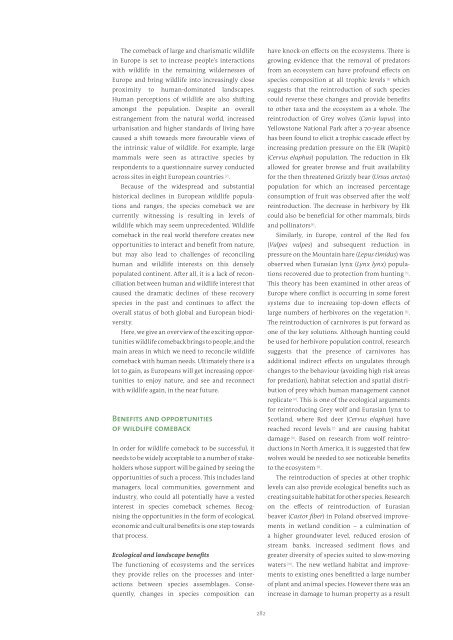130925-studie-wildlife-comeback-in-europe
You also want an ePaper? Increase the reach of your titles
YUMPU automatically turns print PDFs into web optimized ePapers that Google loves.
The <strong>comeback</strong> of large and charismatic <strong>wildlife</strong><br />
<strong>in</strong> Europe is set to <strong>in</strong>crease people’s <strong>in</strong>teractions<br />
with <strong>wildlife</strong> <strong>in</strong> the rema<strong>in</strong><strong>in</strong>g wildernesses of<br />
Europe and br<strong>in</strong>g <strong>wildlife</strong> <strong>in</strong>to <strong>in</strong>creas<strong>in</strong>gly close<br />
proximity to human-dom<strong>in</strong>ated landscapes.<br />
Human perceptions of <strong>wildlife</strong> are also shift<strong>in</strong>g<br />
amongst the population. Despite an overall<br />
estrangement from the natural world, <strong>in</strong>creased<br />
urbanisation and higher standards of liv<strong>in</strong>g have<br />
caused a shift towards more favourable views of<br />
the <strong>in</strong>tr<strong>in</strong>sic value of <strong>wildlife</strong>. For example, large<br />
mammals were seen as attractive species by<br />
respondents to a questionnaire survey conducted<br />
across sites <strong>in</strong> eight European countries [2] .<br />
Because of the widespread and substantial<br />
historical decl<strong>in</strong>es <strong>in</strong> European <strong>wildlife</strong> populations<br />
and ranges, the species <strong>comeback</strong> we are<br />
currently witness<strong>in</strong>g is result<strong>in</strong>g <strong>in</strong> levels of<br />
<strong>wildlife</strong> which may seem unprecedented. Wildlife<br />
<strong>comeback</strong> <strong>in</strong> the real world therefore creates new<br />
opportunities to <strong>in</strong>teract and benefit from nature,<br />
but may also lead to challenges of reconcil<strong>in</strong>g<br />
human and <strong>wildlife</strong> <strong>in</strong>terests on this densely<br />
populated cont<strong>in</strong>ent. After all, it is a lack of reconciliation<br />
between human and <strong>wildlife</strong> <strong>in</strong>terest that<br />
caused the dramatic decl<strong>in</strong>es of these recovery<br />
species <strong>in</strong> the past and cont<strong>in</strong>ues to affect the<br />
overall status of both global and European biodiversity.<br />
Here, we give an overview of the excit<strong>in</strong>g opportunities<br />
<strong>wildlife</strong> <strong>comeback</strong> br<strong>in</strong>gs to people, and the<br />
ma<strong>in</strong> areas <strong>in</strong> which we need to reconcile <strong>wildlife</strong><br />
<strong>comeback</strong> with human needs. Ultimately there is a<br />
lot to ga<strong>in</strong>, as Europeans will get <strong>in</strong>creas<strong>in</strong>g opportunities<br />
to enjoy nature, and see and reconnect<br />
with <strong>wildlife</strong> aga<strong>in</strong>, <strong>in</strong> the near future.<br />
Benefits and opportunities<br />
of <strong>wildlife</strong> <strong>comeback</strong><br />
In order for <strong>wildlife</strong> <strong>comeback</strong> to be successful, it<br />
needs to be widely acceptable to a number of stakeholders<br />
whose support will be ga<strong>in</strong>ed by see<strong>in</strong>g the<br />
opportunities of such a process. This <strong>in</strong>cludes land<br />
managers, local communities, government and<br />
<strong>in</strong>dustry, who could all potentially have a vested<br />
<strong>in</strong>terest <strong>in</strong> species <strong>comeback</strong> schemes. Recognis<strong>in</strong>g<br />
the opportunities <strong>in</strong> the form of ecological,<br />
economic and cultural benefits is one step towards<br />
that process.<br />
Ecological and landscape benefits<br />
The function<strong>in</strong>g of ecosystems and the services<br />
they provide relies on the processes and <strong>in</strong>teractions<br />
between species assemblages. Consequently,<br />
changes <strong>in</strong> species composition can<br />
have knock-on effects on the ecosystems. There is<br />
grow<strong>in</strong>g evidence that the removal of predators<br />
from an ecosystem can have profound effects on<br />
species composition at all trophic levels [3] which<br />
suggests that the re<strong>in</strong>troduction of such species<br />
could reverse these changes and provide benefits<br />
to other taxa and the ecosystem as a whole. The<br />
re<strong>in</strong>troduction of Grey wolves (Canis lupus) <strong>in</strong>to<br />
Yellowstone National Park after a 70-year absence<br />
has been found to elicit a trophic cascade effect by<br />
<strong>in</strong>creas<strong>in</strong>g predation pressure on the Elk (Wapiti)<br />
(Cervus elaphus) population. The reduction <strong>in</strong> Elk<br />
allowed for greater browse and fruit availability<br />
for the then threatened Grizzly bear (Ursus arctos)<br />
population for which an <strong>in</strong>creased percentage<br />
consumption of fruit was observed after the wolf<br />
re<strong>in</strong>troduction. The decrease <strong>in</strong> herbivory by Elk<br />
could also be beneficial for other mammals, birds<br />
and poll<strong>in</strong>ators [4] .<br />
Similarly, <strong>in</strong> Europe, control of the Red fox<br />
(Vulpes vulpes) and subsequent reduction <strong>in</strong><br />
pressure on the Mounta<strong>in</strong> hare (Lepus timidus) was<br />
observed when Eurasian lynx (Lynx lynx) populations<br />
recovered due to protection from hunt<strong>in</strong>g [5] .<br />
This theory has been exam<strong>in</strong>ed <strong>in</strong> other areas of<br />
Europe where conflict is occurr<strong>in</strong>g <strong>in</strong> some forest<br />
systems due to <strong>in</strong>creas<strong>in</strong>g top-down effects of<br />
large numbers of herbivores on the vegetation [6] .<br />
The re<strong>in</strong>troduction of carnivores is put forward as<br />
one of the key solutions. Although hunt<strong>in</strong>g could<br />
be used for herbivore population control, research<br />
suggests that the presence of carnivores has<br />
additional <strong>in</strong>direct effects on ungulates through<br />
changes to the behaviour (avoid<strong>in</strong>g high risk areas<br />
for predation), habitat selection and spatial distribution<br />
of prey which human management cannot<br />
replicate [6] . This is one of the ecological arguments<br />
for re<strong>in</strong>troduc<strong>in</strong>g Grey wolf and Eurasian lynx to<br />
Scotland, where Red deer (Cervus elaphus) have<br />
reached record levels [7] and are caus<strong>in</strong>g habitat<br />
damage [8] . Based on research from wolf re<strong>in</strong>troductions<br />
<strong>in</strong> North America, it is suggested that few<br />
wolves would be needed to see noticeable benefits<br />
to the ecosystem [9] .<br />
The re<strong>in</strong>troduction of species at other trophic<br />
levels can also provide ecological benefits such as<br />
creat<strong>in</strong>g suitable habitat for other species. Research<br />
on the effects of re<strong>in</strong>troduction of Eurasian<br />
beaver (Castor fiber) <strong>in</strong> Poland observed improvements<br />
<strong>in</strong> wetland condition – a culm<strong>in</strong>ation of<br />
a higher groundwater level, reduced erosion of<br />
stream banks, <strong>in</strong>creased sediment flows and<br />
greater diversity of species suited to slow-mov<strong>in</strong>g<br />
waters [10] . The new wetland habitat and improvements<br />
to exist<strong>in</strong>g ones benefitted a large number<br />
of plant and animal species. However there was an<br />
<strong>in</strong>crease <strong>in</strong> damage to human property as a result<br />
282


